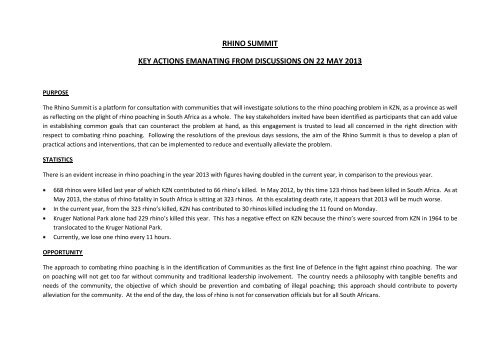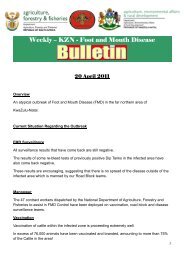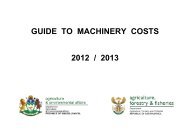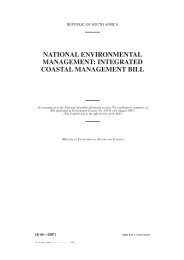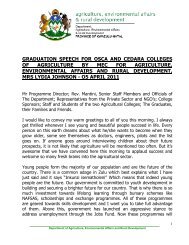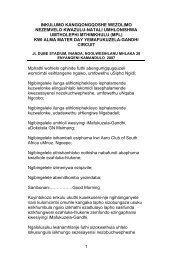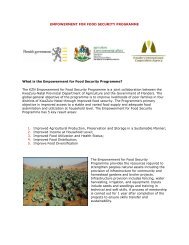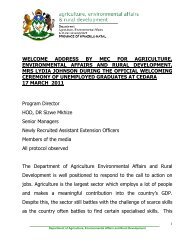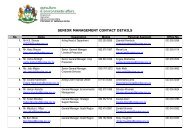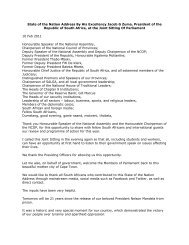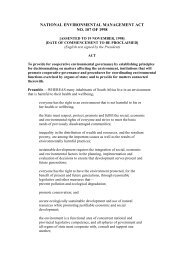rhino summit key actions emanating from discussions on 22 may 2013
rhino summit key actions emanating from discussions on 22 may 2013
rhino summit key actions emanating from discussions on 22 may 2013
Create successful ePaper yourself
Turn your PDF publications into a flip-book with our unique Google optimized e-Paper software.
RHINO SUMMIT<br />
KEY ACTIONS EMANATING FROM DISCUSSIONS ON <strong>22</strong> MAY <strong>2013</strong><br />
PURPOSE<br />
The Rhino Summit is a platform for c<strong>on</strong>sultati<strong>on</strong> with communities that will investigate soluti<strong>on</strong>s to the <str<strong>on</strong>g>rhino</str<strong>on</strong>g> poaching problem in KZN, as a province as well<br />
as reflecting <strong>on</strong> the plight of <str<strong>on</strong>g>rhino</str<strong>on</strong>g> poaching in South Africa as a whole. The <str<strong>on</strong>g>key</str<strong>on</strong>g> stakeholders invited have been identified as participants that can add value<br />
in establishing comm<strong>on</strong> goals that can counteract the problem at hand, as this engagement is trusted to lead all c<strong>on</strong>cerned in the right directi<strong>on</strong> with<br />
respect to combating <str<strong>on</strong>g>rhino</str<strong>on</strong>g> poaching. Following the resoluti<strong>on</strong>s of the previous days sessi<strong>on</strong>s, the aim of the Rhino Summit is thus to develop a plan of<br />
practical <str<strong>on</strong>g>acti<strong>on</strong>s</str<strong>on</strong>g> and interventi<strong>on</strong>s, that can be implemented to reduce and eventually alleviate the problem.<br />
STATISTICS<br />
There is an evident increase in <str<strong>on</strong>g>rhino</str<strong>on</strong>g> poaching in the year <strong>2013</strong> with figures having doubled in the current year, in comparis<strong>on</strong> to the previous year.<br />
668 <str<strong>on</strong>g>rhino</str<strong>on</strong>g>s were killed last year of which KZN c<strong>on</strong>tributed to 66 <str<strong>on</strong>g>rhino</str<strong>on</strong>g>’s killed. In May 2012, by this time 123 <str<strong>on</strong>g>rhino</str<strong>on</strong>g>s had been killed in South Africa. As at<br />
May <strong>2013</strong>, the status of <str<strong>on</strong>g>rhino</str<strong>on</strong>g> fatality in South Africa is sitting at 323 <str<strong>on</strong>g>rhino</str<strong>on</strong>g>s. At this escalating death rate, it appears that <strong>2013</strong> will be much worse.<br />
In the current year, <str<strong>on</strong>g>from</str<strong>on</strong>g> the 323 <str<strong>on</strong>g>rhino</str<strong>on</strong>g>’s killed, KZN has c<strong>on</strong>tributed to 30 <str<strong>on</strong>g>rhino</str<strong>on</strong>g>s killed including the 11 found <strong>on</strong> M<strong>on</strong>day.<br />
Kruger Nati<strong>on</strong>al Park al<strong>on</strong>e had <strong>22</strong>9 <str<strong>on</strong>g>rhino</str<strong>on</strong>g>’s killed this year. This has a negative effect <strong>on</strong> KZN because the <str<strong>on</strong>g>rhino</str<strong>on</strong>g>’s were sourced <str<strong>on</strong>g>from</str<strong>on</strong>g> KZN in 1964 to be<br />
translocated to the Kruger Nati<strong>on</strong>al Park.<br />
Currently, we lose <strong>on</strong>e <str<strong>on</strong>g>rhino</str<strong>on</strong>g> every 11 hours.<br />
OPPORTUNITY<br />
The approach to combating <str<strong>on</strong>g>rhino</str<strong>on</strong>g> poaching is in the identificati<strong>on</strong> of Communities as the first line of Defence in the fight against <str<strong>on</strong>g>rhino</str<strong>on</strong>g> poaching. The war<br />
<strong>on</strong> poaching will not get too far without community and traditi<strong>on</strong>al leadership involvement. The country needs a philosophy with tangible benefits and<br />
needs of the community, the objective of which should be preventi<strong>on</strong> and combating of illegal poaching; this approach should c<strong>on</strong>tribute to poverty<br />
alleviati<strong>on</strong> for the community. At the end of the day, the loss of <str<strong>on</strong>g>rhino</str<strong>on</strong>g> is not for c<strong>on</strong>servati<strong>on</strong> officials but for all South Africans.
WEAKNESSES:<br />
It was questi<strong>on</strong>ed as to why current strategies were failing. A survey c<strong>on</strong>ducted by <strong>on</strong>e of the c<strong>on</strong>servati<strong>on</strong> agencies highlighted that community members<br />
knew about poaching and the people involved in these crimes. The survey further revealed that people were not educated sufficiently to know the link<br />
between humans and animals; it was observed that m<strong>on</strong>ey and greed was a <str<strong>on</strong>g>key</str<strong>on</strong>g> driving force for their involvement in the crime of poaching, the bottom<br />
line being poverty. Additi<strong>on</strong>al c<strong>on</strong>tributors to the failure of <str<strong>on</strong>g>rhino</str<strong>on</strong>g> poaching strategies in KZN include the following:<br />
C<strong>on</strong>tributing to lack of ownership, communities are looking at reserves as for other people and not for them.<br />
Community involvement is currently poor.<br />
Main problem is poverty around the reserves. Even our own field rangers end up collaborating with poachers - collusi<strong>on</strong>.<br />
People that are involved in poaching come <str<strong>on</strong>g>from</str<strong>on</strong>g> the community. The community is aware of who the poachers are.<br />
There is a loss of neighbourly networks. The culture of society has changed and Ubuntu is finished.<br />
Sophisticated poachers have entered the compositi<strong>on</strong> of poachers. Their technology is advanced.<br />
Sensitising the community in terms of awareness about c<strong>on</strong>servati<strong>on</strong> issues and educating them sits at a low level. People are easily mis-led into<br />
believing lies and myths in return for financial rewards that are not worth the price of a <str<strong>on</strong>g>rhino</str<strong>on</strong>g>.<br />
Educati<strong>on</strong> imperative; people do not know the basics such as what a <str<strong>on</strong>g>rhino</str<strong>on</strong>g> looks like and the difference in <str<strong>on</strong>g>rhino</str<strong>on</strong>g> features.<br />
Poor relati<strong>on</strong>ship between the community and reserve management due to factors such as problem animals. This makes reporting any suspici<strong>on</strong>s, hard<br />
for the community.<br />
RECOMMENDATIONS:<br />
The soluti<strong>on</strong>s recommended yesterday are community based and require support <str<strong>on</strong>g>from</str<strong>on</strong>g> the government:<br />
No. Area Community Based Soluti<strong>on</strong>s Government<br />
1. Ownership The community needs to acknowledge its resources and assume<br />
ownership of natural resources of its heritage. The focus is <strong>on</strong><br />
protecting its own property and this new culture needs to be<br />
cultivated in this regard.<br />
Co-management needs to happen. The requirements of comanagement<br />
agreement need to be fulfilled (i.e. full access to<br />
informati<strong>on</strong>; n<strong>on</strong>-discriminatory social envir<strong>on</strong>ment; c<strong>on</strong>fidence in<br />
sharing of agreements; and sharing of resources).
2. Intelligence The community must serve as a new breed of rangers in being the<br />
first line of defence in <str<strong>on</strong>g>rhino</str<strong>on</strong>g> poaching as a strategy. Community is to<br />
provide extra help in the form of being the main eyes and ears for the<br />
strategies to be effective. This leads to the creati<strong>on</strong> of effective<br />
leaders <str<strong>on</strong>g>from</str<strong>on</strong>g> community and high community involvement.<br />
Impimpi’s need to be reinforced and can be used to source<br />
informati<strong>on</strong> timeously e.g. informati<strong>on</strong> about a people that are in the<br />
community but do not bel<strong>on</strong>g to the community. Acti<strong>on</strong>s can be put<br />
in place to tackle the intruder.<br />
Community relati<strong>on</strong>ship with Ambassadors should be heightened and<br />
strengthened.<br />
Less<strong>on</strong>s <str<strong>on</strong>g>from</str<strong>on</strong>g> the past must be learnt<br />
3. Awareness<br />
and<br />
Educati<strong>on</strong><br />
4. Community<br />
Development<br />
Amakhosi need to be leaders in teaching the communities.<br />
Resp<strong>on</strong>sible hunting for livelihood and not profit making should be<br />
promoted.<br />
Communities must cascade the knowledge <strong>on</strong> <str<strong>on</strong>g>rhino</str<strong>on</strong>g>’s c<strong>on</strong>servati<strong>on</strong><br />
management to their children.<br />
Communities are to create <strong>on</strong>going awareness during community<br />
events such as Amakhosi’s hosting Imbizo’s; awareness and educati<strong>on</strong><br />
should take place at community gatherings; the rate of meetings<br />
should increase with <str<strong>on</strong>g>rhino</str<strong>on</strong>g> poaching <strong>on</strong> the agenda.<br />
Strengthening of Local Structures, as there is a need to start<br />
introducing the issues of <str<strong>on</strong>g>rhino</str<strong>on</strong>g> poaching and illegal harvesting.<br />
The community must know the value of a live <str<strong>on</strong>g>rhino</str<strong>on</strong>g> (R1,6 milli<strong>on</strong>).<br />
Scientific training is required instead of management training.<br />
In Co-management agreements, the community should be a<br />
beneficiary <str<strong>on</strong>g>from</str<strong>on</strong>g> community c<strong>on</strong>servati<strong>on</strong>.<br />
An increase in tourism must mean benefit for the communities.<br />
Formal structures in place to off-take animals must be understood<br />
and used by the community.<br />
Intelligence gatherers can be analysed and used in<br />
future strategies.<br />
Community informers need to have c<strong>on</strong>fidential<br />
relati<strong>on</strong>s with c<strong>on</strong>servati<strong>on</strong> agencies or the police.<br />
Government should organise access for the<br />
community into the reserves.<br />
C<strong>on</strong>servati<strong>on</strong> Agencies must c<strong>on</strong>tribute to the<br />
awareness and educati<strong>on</strong> of communities especially<br />
the importance of saving the <str<strong>on</strong>g>rhino</str<strong>on</strong>g>’s.<br />
Training and Development programme is required to<br />
develop c<strong>on</strong>servati<strong>on</strong> related skills for the<br />
community such as in the form of bursaries.<br />
In turn, the Leadership also need awareness <str<strong>on</strong>g>from</str<strong>on</strong>g> the<br />
community: People champi<strong>on</strong>ing anti-<str<strong>on</strong>g>rhino</str<strong>on</strong>g><br />
campaigns do not understand needs of the<br />
community and need to be educated <strong>on</strong> this.<br />
Ec<strong>on</strong>omic development projects should be<br />
implemented to meet the needs of the community<br />
which is said to be poor e.g. dealing with the crisis of<br />
unemployment through increased job creati<strong>on</strong> with<br />
increased benefits.<br />
Tourism benefits <str<strong>on</strong>g>from</str<strong>on</strong>g> the Reserve should have a<br />
positive implicati<strong>on</strong> for the community.<br />
C<strong>on</strong>tribute to livelihoods and make it evident e.g.<br />
Youth should be provided with uniform and<br />
stati<strong>on</strong>ery.<br />
C<strong>on</strong>tribute to dealing with community poverty and<br />
basic needs such as water and electricity.
5. Law<br />
Enforcement<br />
6. Weap<strong>on</strong>s for<br />
War and<br />
tactics<br />
7. Alliance<br />
Formulati<strong>on</strong><br />
Government needs to check visitors in terms of their reas<strong>on</strong>s for<br />
being in the country and past criminal checks.<br />
The Sentencing process should be made that it’s high so that<br />
poachers know the c<strong>on</strong>sequences.<br />
How can you involve community The community should be allowed<br />
to comment and c<strong>on</strong>tribute to the plans and interventi<strong>on</strong>s..<br />
We will need to increase law enforcement results by<br />
increasing sentencing so that people can see how<br />
serious the repercussi<strong>on</strong>s can be.<br />
It was commented that the department of justice<br />
supports the criminals with lawyers.<br />
Suggesti<strong>on</strong> to treat criminals just like how<br />
internati<strong>on</strong>al law enforcement treats criminals.<br />
Require sophisticated equipment and training to fight poachers.<br />
Community involvement in the form of c<strong>on</strong>ducting fence patrols.<br />
All <str<strong>on</strong>g>rhino</str<strong>on</strong>g>s must be inserted with micro-chips.<br />
The de-horning of <str<strong>on</strong>g>rhino</str<strong>on</strong>g>’s has decreased poaching in other c<strong>on</strong>servati<strong>on</strong> agencies. However, this has a negative advantage <strong>on</strong><br />
tourism.<br />
Investigate what is going <strong>on</strong> at airports in terms of how the horns are passing through airports.<br />
Investigate whether it is possible to weight the people coming into the country such as probing them <strong>on</strong> past criminal<br />
involvement, their reas<strong>on</strong> for being in the country, etc.<br />
Suggesti<strong>on</strong> that <str<strong>on</strong>g>rhino</str<strong>on</strong>g> trading be legalized in which parameters will be set to catch the poachers out. Legal <str<strong>on</strong>g>rhino</str<strong>on</strong>g> horn trade can<br />
reduce poaching.<br />
It is important for relati<strong>on</strong>ships to be established am<strong>on</strong>g the South African government, NGO’s and Communities in order to cultivate<br />
a sense of teamwork and togetherness in the fight against <str<strong>on</strong>g>rhino</str<strong>on</strong>g> poaching. In strengthening relati<strong>on</strong>ships, the following strategic<br />
alliances can be formed am<strong>on</strong>g all <str<strong>on</strong>g>key</str<strong>on</strong>g> stakeholders c<strong>on</strong>sidering that this a joint effort:<br />
Alliance between the Communities adjacent to the reserves and the Reserve Management (C<strong>on</strong>servati<strong>on</strong> Agency); the sharing of<br />
benefits and losses is crucial for good relati<strong>on</strong>s. Suggesti<strong>on</strong>s including the Anti-poaching Unit, Community Development Unit<br />
(Awareness in community schools, churches, envir<strong>on</strong>ment clubs, traditi<strong>on</strong>al leadership), and Park Forums (used to deliver<br />
messages).<br />
Alliance between the Amakhosi and Traditi<strong>on</strong>al Healers to the Community; the Amakhosi are resp<strong>on</strong>sible for re-introducing the<br />
culture of Ubuntu am<strong>on</strong>gst community members.<br />
Alliance between the Amakhosi and Traditi<strong>on</strong>al Healers to the C<strong>on</strong>servati<strong>on</strong> Agency. It is suggested that Healers must be<br />
officialised within the communities in the form of formally appointing them as Healers via formal training in order to eradicate<br />
criminal healers.<br />
Alliance by all stakeholders menti<strong>on</strong>ed above with the South African Police. Involvement in Police Forums.<br />
Alliance by the C<strong>on</strong>servati<strong>on</strong> Agency and Public Prosecutors.<br />
Communities with no Inkosi such as townships, should also be c<strong>on</strong>sidered in the formati<strong>on</strong> of alliances; this includes Councillors<br />
and other strategic partners.
QUESTIONS<br />
1. How do we deal with the suspici<strong>on</strong> that field rangers working within c<strong>on</strong>servati<strong>on</strong> areas are involved in poaching<br />
2. If there is informati<strong>on</strong> in the community, who can the community c<strong>on</strong>tact to take acti<strong>on</strong> so as to enable speedy reacti<strong>on</strong> to the situati<strong>on</strong><br />
3. There is no structure for reporting; who is the community to engage with as there are field rangers, police, soldiers, government police, etc Who<br />
resp<strong>on</strong>ds<br />
4. Who to trust in the Reserve to whom the community can report the issues<br />
5. The Rhino Summit lacked representati<strong>on</strong> by the SANDF, NPA, etc. Should they not have been invited<br />
6. We hear you that Amakhosi are saying we must c<strong>on</strong>tribute as the poachers come <str<strong>on</strong>g>from</str<strong>on</strong>g> the community. It would be nice if some<strong>on</strong>e is caught, then it’s<br />
nice to say that the poacher is coming <str<strong>on</strong>g>from</str<strong>on</strong>g> a specific inkosi area Can the c<strong>on</strong>servati<strong>on</strong> agency not be able to identify where the pers<strong>on</strong> is coming <str<strong>on</strong>g>from</str<strong>on</strong>g><br />
in view of the source of poachers This is the type of informati<strong>on</strong> required by Amakhosias feedback <str<strong>on</strong>g>from</str<strong>on</strong>g> investigati<strong>on</strong>s.<br />
7. Can the tracking methods and skills of Traditi<strong>on</strong>al Healers not be used in the fight against poachers<br />
8. Induna is not in the township, how will the Inkosi talk to people in the townships as these places are headed by councillors<br />
9. How safe is the community member It was commented that it is very hard for the community to come out especially because they are not protected<br />
at home<br />
10. What is making it difficult for the community to inform the c<strong>on</strong>servati<strong>on</strong> agencies about their suspici<strong>on</strong>s What makes it difficult for the community not<br />
to come forward<br />
11. This forum is unrepresentative of the SANDF, NPA, who are not available. This needs to be nati<strong>on</strong>al problem. What do you do to close the market and<br />
make it a nati<strong>on</strong>al thing<br />
12. Why can’t Ezemvelo make a promise to commit to the community financially as a means of reducing poaching<br />
13. Suggesti<strong>on</strong> to breed <str<strong>on</strong>g>rhino</str<strong>on</strong>g>’s at an increased level to meet the demand <str<strong>on</strong>g>from</str<strong>on</strong>g> the internati<strong>on</strong>al market. The feeling was that, even if the community did<br />
make a c<strong>on</strong>tributi<strong>on</strong>, this would not resolve the problem. The <str<strong>on</strong>g>rhino</str<strong>on</strong>g>’s could be dehorned, the horns sold individually and the black market sales would<br />
be reduced.<br />
14. Mozambique and Swaziland are c<strong>on</strong>nected<br />
CONCLUSION<br />
The plan of acti<strong>on</strong> and interventi<strong>on</strong> will require implementati<strong>on</strong> by Communities, Amakhosi, Izinduna, Traditi<strong>on</strong>al Healers, C<strong>on</strong>servati<strong>on</strong> Agencies and the<br />
required stakeholders so that the next Rhino Summit will focus <strong>on</strong> evaluating the <str<strong>on</strong>g>acti<strong>on</strong>s</str<strong>on</strong>g> and interventi<strong>on</strong>s that have been successful in the fight against<br />
<str<strong>on</strong>g>rhino</str<strong>on</strong>g> poaching .


